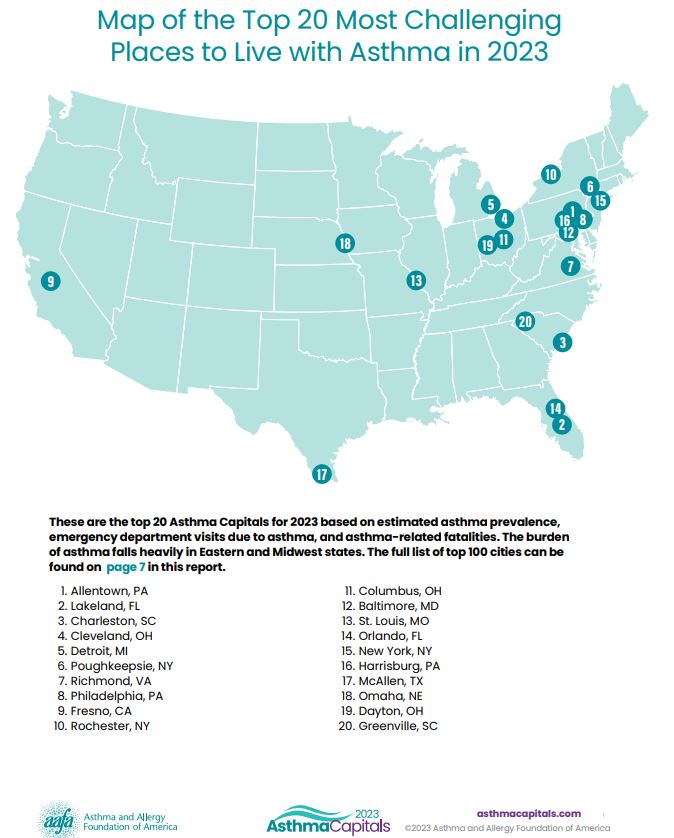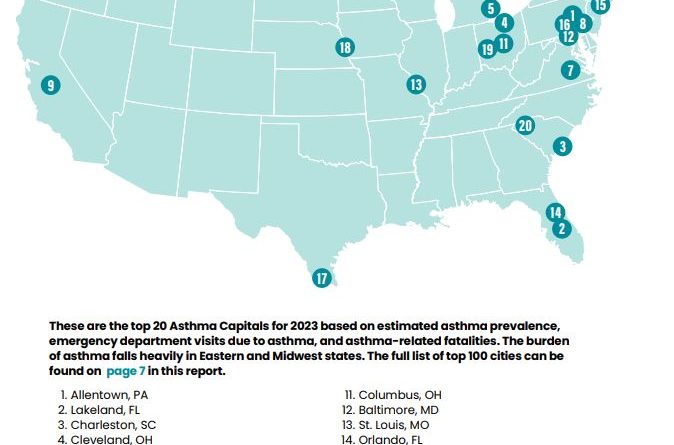Asthma is greatly influenced by where someone lives. People who have affordable and accessible health care, clean air, and economic stability have a greater chance of managing and controlling their asthma. AAFA’s Asthma Capitals™ report ranks the largest 100 cities in the continental U.S. by how challenging they are to live in when you have asthma. AAFA publishes this report to show the nationwide burden of asthma. It is a call to action to help the more than 27 million people in the U.S. with asthma.
The Asthma Capitals report ranking is based on three health outcomes: asthma prevalence, emergency department visits for asthma, and deaths due to asthma.
The report also discusses risk factors that contribute to these outcomes: poverty, air quality, access to specialist medical care, pollen allergy, medicine use, tobacco policies, and the rate of uninsured residents.

Asthma Peak Month
This year’s report has been released during September to raise awareness of the spike in asthma-related attacks and hospital stays that happen each September. It is known as Asthma Peak Month, or the September Asthma Epidemic. The third week of the month – known as Asthma Peak Week – is often the worst.
People with asthma are exposed to several triggers at once during September, such as:
- Higher ragweed pollen
- Higher mold counts
- The beginning of respiratory illness season
- Poor indoor air quality in schools
- Wildfire-related air pollution
- Extreme weather events and natural disasters, such as hurricanes, heat waves, and extreme thunderstorms
Report Highlights
It is AAFA’s goal that the 2023 Asthma Capitals report inspires action. Reduced asthma rates and deaths are possible. And this report highlights where we can focus our efforts for healthier environments and communities. This year’s report focuses on three topics related to asthma prevalence and outcomes:
- Reducing health disparities in communities that bear the heaviest burden of asthma
- Taking steps to improve asthma outcomes
- Taking action through advocacy and policy
Reducing Health Disparities in Communities that Bear the Heaviest Burden of Asthma
This report acknowledges that where a person lives can greatly impact their health. Social, economic, and environmental factors play a role in asthma outcomes. Many of the top Asthma Capitals are also facing major challenges and inequities that lead to health disparities.
AAFA’s Health Equity Advancement and Leadership (HEAL) program reinforces AAFA’s commitment to drastically reduce health disparities in communities that bear the heaviest burden of asthma. Through the HEAL program, AAFA provides funding and resources to local pilot programs tailored to at-risk populations most impacted by asthma.
Learn more about health equity and the HEAL program in our report.
Source: https://aafa.org/wp-content/uploads/2023/09/aafa-2023-asthma-capitals-report.pdf

